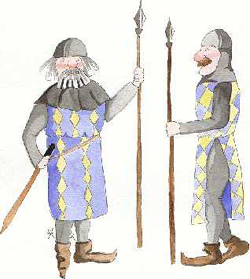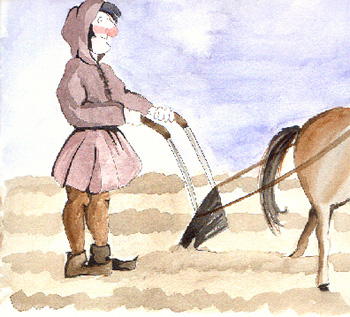| |
|
The Middle Ages is the period in European history between the collapse of Roman civilization, around the 5th century, and the beginning of the Renaissance, at the end of the 15th century.
The Era, covering almost a thousand years, is often regarded as a period of decline bordered by two epochs of high civilization, the Classical Age of Ancient Greece and Rome at one end, and the Renaissance, at the other.
However, The Middle Ages was also a period of progress, as it saw the reign of Charlemagne, the growth of Christianity and the building of the impressive Gothic cathedrals.
|
|
| |
|
At that time, Western Europe was organized by the Feudal system.
The king owned the land, which was divided into areas known as Manors. The lord of the manor was the king's vassal, who swore loyalty to the king and promised to provide fighting men to defend the kingdom.
The Lord and the vassal were both free men and their relationship was based on a contract sealed by oaths of homage and fidelity. So the vassal not only took the oath of fidelity (fielty), which everyone owed to his lord, but also a special oath of homage to the feudal lord, who invested him with a fief.
|
|

|
|
| |
|
Their relationship was then based on need and trust:
- Regular supply of troops: when the lord had a castle, he might ask his vassals to garrison it - a service called Castle-guard.
- If the lord needed money, he expected his vassals to give him finantial aid in exchange for the lands he had given them. So, they had to share part of the wealth they got from the lands.
- The lord also expected his vassals to attend in Court, to give him advice and to take part in judgements of cases concerning other vassals.
As the feudal relationship was contractual, false actions on either side could cause the breach of the contract, and the vassal's family could even lose the fief.
On the other hand, the relationship between the lord and his peasants - the serfs or villeins - was called seignorialism.
|
|
| |
|

|
|
Peasants were at the bottom of the social ladder. They lived in villages and worked the land, which was owned by the lord of the manor, to whom the peasants gave a share of the crops. They used to wear roughly woven clothes and wooden shoes. they lived off porridge, turnips, beans, dark bread and weak beer.
|
|
| |
|
So, in Medieval Europe, the work people did, the food they ate, the clothes they wore and the dwellings in which they lived were all fixed by their place in society.
|
|
|









